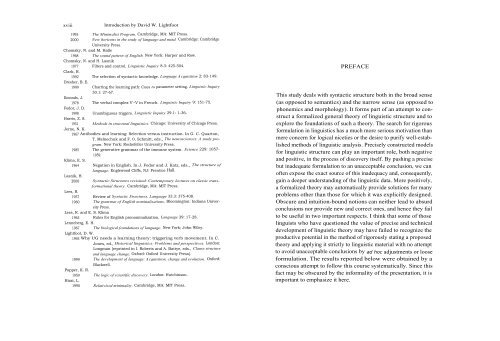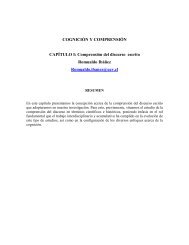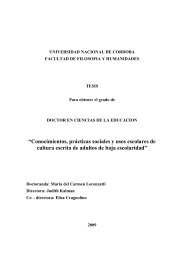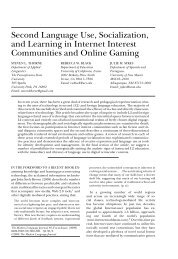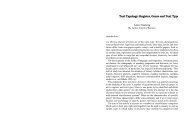Syntactic Structures
Syntactic Structures
Syntactic Structures
Create successful ePaper yourself
Turn your PDF publications into a flip-book with our unique Google optimized e-Paper software.
xviii Introduction by David W. Lightfoot<br />
1995 The Minimalist Program. Cambridge, MA: MIT Press.<br />
2000 New horizons in the study of language and mind. Cambridge: Cambridge<br />
University Press.<br />
Chomsky, N. and M. Halle<br />
1968 The sound pattern of English. New York: Harper and Row.<br />
Chomsky, N. and H. Lasnik<br />
1977 Filters and control. Linguistic Inquiry 8.3: 425-504.<br />
Clark, R.<br />
1992 The selection of syntactic knowledge. Language Acquisition 2: 83-149.<br />
Dresher, B. E.<br />
1999 Charting the learning path: Cues to parameter setting. Linguistic Inquiry<br />
30.1: 27-67.<br />
Emonds, J.<br />
1978 The verbal complex V'–V in French. Linguistic Inquiry 9: 151-75.<br />
Fodor, J. D.<br />
1998 Unambiguous triggers. Linguistic Inquiry 29.1: 1-36.<br />
Harris, Z. S.<br />
1951 Methods in structural linguistics. Chicago: University of Chicago Press.<br />
Jerne, N. K.<br />
1967 Antibodies and learning: Selection versus instruction. In G. C. Quarton,<br />
T. Melnechuk and F. 0. Schmitt, eds., The neurosciences: A study program.<br />
New York: Rockefeller University Press.<br />
1985 The generative grammar of the immune system. Science 229: 1057-<br />
1059.<br />
Klima, E. S.<br />
1964 Negation in English. In J. Fodor and J. Katz, eds., The structure of<br />
language. Englewood Cliffs, NJ: Prentice Hall.<br />
Lasnik, H.<br />
2000 <strong>Syntactic</strong> <strong>Structures</strong> revisited: Contemporary lectures on classic transformational<br />
theory. Cambridge, MA: MIT Press.<br />
Lees, R.<br />
1957 Review of <strong>Syntactic</strong> <strong>Structures</strong>. Language 33.3: 375-408.<br />
1960 The grammar of English nominalizations. Bloomington: Indiana University<br />
Press.<br />
Lees, R. and E. S. Klima<br />
1963 Rules for English pronominalization. Language 39: 17-28.<br />
Lenneberg, E. H.<br />
1967 The biological foundations of language. New York; John Wiley.<br />
Lightfoot, D. W.<br />
1993 Why UG needs a learning theory: triggering verb movement. In C.<br />
Jones, ed., Historical linguistics: Problems and perspectives. London:<br />
Longman [reprinted in I. Roberts and A. Battye, eds., Clause structure<br />
and language change. Oxford: Oxford University Press].<br />
1999 The development of language: Acquisition, change and evolution. Oxford:<br />
Blackwell.<br />
Popper, K. R.<br />
1959 The logic of scientific discovery. London: Hutchinson.<br />
Rizzi, L.<br />
1990 Relativized minimality. Cambridge, MA: MIT Press.<br />
PREFACE<br />
This study deals with syntactic structure both in the broad sense<br />
(as opposed to semantics) and the narrow sense (as opposed to<br />
phonemics and morphology). It forms part of an attempt to construct<br />
a formalized general theory of linguistic structure and to<br />
explore the foundations of such a theory. The search for rigorous<br />
formulation in linguistics has a much more serious motivation than<br />
mere concern for logical niceties or the desire to purify well-established<br />
methods of linguistic analysis. Precisely constructed models<br />
for linguistic structure can play an important role, both negative<br />
and positive, in the process of discovery itself. By pushing a precise<br />
but inadequate formulation to an unacceptable conclusion, we can<br />
often expose the exact source of this inadequacy and, consequently,<br />
gain a deeper understanding of the linguistic data. More positively,<br />
a formalized theory may automatically provide solutions for many<br />
problems other than those for which it was explicitly designed.<br />
Obscure and intuition-bound notions can neither lead to absurd<br />
conclusions nor provide new and correct ones, and hence they fail<br />
to be useful in two important respects. I think that some of those<br />
linguists who have questioned the value of precise and technical<br />
development of linguistic theory may have failed to recognize the<br />
productive potential in the method of rigorously stating a proposed<br />
theory and applying it strictly to linguistic material with no attempt<br />
to avoid unacceptable conclusions by ad hoc adjustments or loose<br />
formulation. The results reported below were obtained by a<br />
conscious attempt to follow this course systematically. Since this<br />
fact may be obscured by the informality of the presentation, it is<br />
important to emphasize it here.


